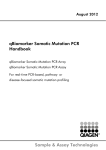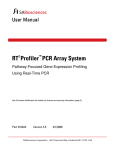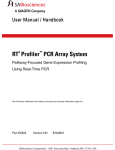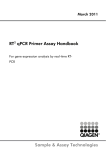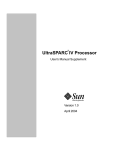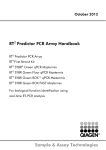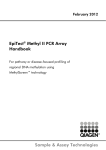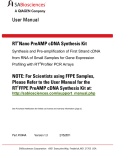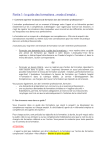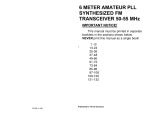Download User Manual - SABiosciences
Transcript
March 2011 qBiomarker Somatic Mutation PCR Handbook qBiomarker Somatic Mutation PCR Array qBiomarker Somatic Mutation PCR Assay For real-time PCR-based, pathway-focused, somatic mutation profiling Sample & Assay Technologies QIAGEN Sample and Assay Technologies QIAGEN is the leading provider of innovative sample and assay technologies, enabling the isolation and detection of contents of any biological sample. Our advanced, high-quality products and services ensure success from sample to result. QIAGEN sets standards in: Purification of DNA, RNA, and proteins Nucleic acid and protein assays microRNA research and RNAi Automation of sample and assay technologies Our mission is to enable you to achieve outstanding success and breakthroughs. For more information, visit www.qiagen.com. Product Use Limitations The qBiomarker Somatic Mutation PCR Array and qBiomarker Somatic Mutation PCR Assay products are intended for molecular biology applications. These products are not intended for the diagnosis, prevention, or treatment of a disease. All due care and attention should be exercised in the handling of the products. We recommend all users of QIAGEN® products to adhere to the NIH guidelines that have been developed for recombinant DNA experiments, or to other applicable guidelines. CONTENTS I. Background and Introduction 4 II. Materials Provided 9 III. Additional Materials Required 12 IV. Protocol 13 A. Genomic DNA Preparation and Quality Control 14 B. qBiomarker Somatic Mutation PCR Array Protocol 16 C. qBiomarker Somatic Mutation PCR Assay Protocol 23 D. Data Analysis 25 E. DNA QC Plate 27 V. Troubleshooting and Frequently Asked Questions 29 I. Introduction Acquisition of somatic mutations in human genomic DNA (gDNA) is an important event during tumorigenesis and cancer progression. Somatic mutations occur as single mutations within a gene, multiple mutations within a gene, or mutations present across related genes in a variety of cancers. Cells may respond differently to treatment regimens based on their somatic mutation profile. For example, the mutation status of the EGFR and KRAS genes can predict the physiological response to certain drugs targeting these molecules. The utility of individual and multiple somatic mutation status information in identifying key signaling transduction disruptions has been demonstrated in numerous research studies. The pathway-focused qBiomarker Somatic Mutation PCR Arrays are translational research tools that allow rapid and accurate profiling of the somatic mutation status for a pathway-focused set of genes and key downstream and associated signaling genes. For example, the EGFR Pathway qBiomarker Somatic Mutation PCR Array, with its comprehensive content coverage, is designed for studying mutations in the context of the EGFR pathway and has the potential for discovering and verifying drug target biomarkers for targeted therapy research involving the EGFR signaling pathway and downstream effectors. For targeted therapy research, studying the most common and clinically relevant mutations in the context of biological pathways provides more coverage and thus the most potential for the discovery and verification of clinical biomarkers. Principle and Procedure Real-time PCR is the most sensitive and reliable method for the detection of DNA mutations. By combining allele specific amplification and hydrolysis probe detection, real-time PCR assays have been developed which can detect as low as 1% somatic mutations in the background of wild-type genomic DNA. Allele specific amplification is achieved by Amplification Refractory Mutation System (ARMS®) technology, which is based on the discrimination by Taq polymerase between a match and a mismatch at the 3’ end of the PCR primer (Figure 1). 4 qBiomarker Somatic Mutation PCR System Figure 1. Amplification Refractory Mutation System (ARMS) The qBiomarker Somatic Mutation PCR Arrays are designed to analyze a panel of somatic mutations reported in the important genes related to a biological pathway. The mutations are selected from comprehensive somatic mutation databases (e.g. COSMIC) and peer-reviewed scientific literature based on their clinical or functional relevance and frequency of occurrence. To complete the qBiomarker Somatic Mutation PCR Array procedure (Figure 2), start with 5 to 10 ng genomic DNA isolated from fresh (unfrozen) or frozen human tissues, or as low as 200 ng DNA from formalin-fixed, paraffin-embedded (FFPE) sections. DNA from fresh tissues can be uniformly amplified using QIAGEN REPLI-g® UltraFast Mini Kit. Then, mix your DNA with the included ready-to-use qBiomarker Probe Mastermixes and aliquot the mixture into each well of the same plate containing pre-dispensed genespecific primer and hydrolysis probe sets. By performing real-time PCR, the mutation status of a particular sample is determined by comparing the allele specific Ct values between your test sample and a wild-type control sample (see the qBiomarker Somatic Mutation Data Analysis section for detailed principles). Each array contains a panel of hydrolysis probe assays for a stringently selected set of pathway focused somatic mutations, gene copy number controls, and PCR quality controls. The qBiomarker Somatic Mutation PCR Arrays are available in both 96-well and 384-well plate formats, containing either one or four replicates, respectively, of the 96-assay set panel (see Figure 3 for the layout of a typical qBiomarker Somatic Mutation PCR Array). qBiomarker Somatic Mutation PCR Assays and qBiomarker Probe Mastermixes have been pre-optimized hand-in-hand for hydrolysis probe based realtime RT-PCR detection. The simplicity of the qBiomarker Somatic Mutation PCR Array format and operating procedure allows routine somatic mutation profiling in any research laboratory with access to real-time PCR instruments. 5 Benefits of the qBiomarker Somatic Mutation PCR Arrays: Pathway Focused: Profile the somatic mutation status of important genes relevant to major signal transduction pathways. Simple and Accurate: Simple real-time PCR procedure provides high sensitivity and wide dynamic range. Designed for Routine Use: Bring somatic mutation profiling to any lab with a realtime PCR instrument. Figure 2: Overview of the qBiomarker Somatic Mutation PCR Array / Assay Protocol Figure 2. Overview of the qBiomarker Somatic Mutation PCR Array / Assay Protocol. The procedure involves DNA extraction (QIAGEN QIAamp® DNA Mini Kit or QIAamp DNA FFPE Tissue Kit are recommended), an optional amplification (QIAGEN REPLI-g Kit or REPLI-g UltraFast Mini Kit are recommended) step for DNA isolated from fresh samples, qPCR detection on qBiomarker Somatic Mutation PCR Arrays or Assays, and data analysis (using the qBiomarker Somatic Mutation Data Analysis Template). An optional DNA sample QC step immediately before the detection array or assay setup allows the user to qualify the DNA samples. For “DNA QC Plate Setup”, refer to Appendix A on page 27. 6 qBiomarker Somatic Mutation PCR System Figure 3: Layout of Pathway-Focused qBiomarker Somatic Mutation PCR Arrays Wells A1 through H1 contain assays for somatic mutations in the same biological pathway. Wells H2 through H10 contain gene copy control assays to normalize PCR Array data. Depending on the specific array content, slight variations in plate layout can occur. Wells H10 through H12 contain replicate Positive PCR Controls (SMPC) to test for the presence of inhibitors in the sample or efficiency of the polymerase chain reaction itself using a pre-dispensed artificial DNA sequence and the primer set that detects it. 7 The 384-well format of the qBiomarker Somatic Mutation PCR Arrays includes four replicates of the same 96-well format, in which each two-by-two set of wells (wells labeled 1 - 4 in gray above) contains the same primer set represented by the 96-well designations. 8 qBiomarker Somatic Mutation PCR System II. Materials Provided: 1. qBiomarker Somatic Mutation PCR Array Plates The qBiomarker Somatic Mutation PCR Arrays are available in 6 different plate formats, each tailored to a specific subset of real-time PCR instruments & associated blocks. Formats A, C, D, and F are 96-well plates, and Formats E & G are 384-well plates. Plate Master Mix Format Reference Dye A Fluoroscein A ROX™ C ROX D ROX E ROX F ROX G ROX For Real-Time Instruments Bio-Rad® iCycler®, iQ™5, MyiQ™, MyiQ2 Plate 96-well ABI Standard 96-well Blocks (5700, 7000, 7300, 7500, 96-well 7900HT, ViiA™ 7); Bio-Rad Chromo4™ (MJ Research); Stratagene® Mx3005P®, Mx3000P®; Eppendorf® ep realplex 2/2S, 4/4S ABI 7500 FAST 96-well Block, 7900HT FAST 96-Well 96-well Block, StepOnePlus™, ViiA 7 FAST 96-well Block 96-well Bio-Rad CFX96™, Opticon and Opticon 2 (MJ Research); Stratagene Mx4000® ABI 7900HT 384-well Block, ViiA 7 384-well Block; Bio- 384-well Rad CFX384™ 96-well Roche® LightCycler® 480 96-well Block 384-well Roche LightCycler 480 384-well Block NOTE: The format of the qBiomarker Somatic Mutation PCR Array is indicated by the last letter of the catalog number. Be sure that you have the correct PCR Array format for your instrument before starting the experiment. The 96-well qBiomarker Somatic Mutation PCR Arrays (Formats A, C, D, and F) are shipped in sets of two (2), twenty-five (25), or one hundred (100), while the 384-well qBiomarker Somatic Mutation PCR Arrays (Formats E and G) are shipped in sets of twenty-five (25) or one hundred (100). Each qBiomarker Somatic Mutation PCR Array shipment includes the arrays and either 12 optical thin-wall 8-cap strips (Formats A and D) or one optical adhesive film (Formats C, E, F, and G) per array. Each 96x4 Format 384-Well qBiomarker Somatic Mutation PCR Array (Formats E and G) also includes one set of 4 384EZLoad Covers (Catalog # 338125) for each qBiomarker Somatic Mutation PCR Array provided in the package. NOTE: Each 384EZLoad Cover is for a Single Use ONLY. 9 2. qBiomarker Probe Mastermixes: Be sure to pick the correct one for the instrumentation in your laboratory. qBiomarker Probe Mastermix ROX: Specifically designed for: • All ABI and Stratagene Instrumentation • All Instruments that do not require a reference dye, such as: o Bio-Rad Opticon, Opticon 2, and Chromo 4 o Roche LightCycler 480 System o Eppendorf Mastercycler® ep realplex 2/2S/4/4S qBiomarker Probe Mastermix Fluorescein: Specifically designed for: • BioRad iCycler, MyiQ, and iQ5 Instrumentation 10 qBiomarker Somatic Mutation PCR System Shipping & Storage Conditions Please check the kit components immediately after you receive this package. We are only responsible for missing items reported within two (2) business days of receipt. qBiomarker Somatic Mutation PCR Arrays: 337021: SMX-###V(F/R)Y-ZZ • X = Species (H = Human); • ### = Somatic Mutation Pathway Identifier; • V = Design Version; • Y = Plate Format; • ZZ = Pack Size; • F/R = Accompanying Master Mix with Reference Dye (Fluorescein or ROX) Shipping Conditions: qBiomarker Somatic Mutation PCR Arrays are shipped at Room Temperature (RT) or on Blue Ice (BI). Storage Conditions: Keep plates at -20ºC for long-term storage. qBiomarker Probe Mastermixes Shipping Conditions: qBiomarker Probe Mastermixes are shipped on Blue Ice (BI). Storage Conditions: Keep qBiomarker Probe Mastermixes at 4ºC for long-term storage. NOTE: Be sure that you have the correct qBiomarker Somatic Mutation PCR Array format and Mastermix (with correct Reference Dye) for your instrument before starting the experiment qBiomarker Somatic Mutation PCR Assays: 337011: SMPX-######A(R/F) • X = Species (H = Human); • ###### = Somatic Mutation Identification Code; • A = Design Version; • R/F = Accompanying Master Mix with Reference Dye (ROX or Fluorescein). Shipping Conditions: qBiomarker Somatic Mutation PCR Assays are shipped on Blue Ice (BI). Storage Conditions: Keep qBiomarker Somatic Mutation PCR Assays at -20ºC for longterm storage. qBiomarker Probe Mastermixes Shipping Conditions: qBiomarker Probe Mastermixes are shipped on Blue Ice (BI). Storage Conditions: Keep qBiomarker Probe Mastermixes at 4ºC for long-term storage. NOTE: Be sure that you have the correct Mastermix (with correct Reference Dye) for your instrument before starting the experiment. When stored properly at the recommended conditions, their performance is guaranteed for 6 months. 11 III. Additional Materials: i. Required A. Genomic DNA Isolation: See Page 14 for specific recommendations. B. High-quality, nuclease-free H2O. DO NOT USE DEPC H2O. C. Equipment: 1. For recommendations on specific real-time instrumentation (thermal cyclers with fluorescent detection), see the list of plate formats above. a. NOTE: The qBiomarker Somatic Mutation PCR Arrays are NOT recommended for the Cepheid SmartCycler®, the Roche LightCycler 2.0, or the QIAGEN Rotor-Gene® Q due to the different non-traditional hot block arrangements in these instruments. 2. Calibrated Multi-Channel Pipettor 3. RNase / DNase-free pipette tips and tubes ii. Optional A. QIAGEN REPLI-g UltraFast Mini Kit: Cat #150033. 12 qBiomarker Somatic Mutation PCR System IV. Protocol: Please read through this entire protocol before beginning your experiment. The chemically modified and tightly controlled HotStart enzyme, along with other proprietary chemical components in the qBiomarker Probe Mastermixes, uniquely provide accurate hydrolysis probe assay PCR results by preventing the amplification of non-specific products. The combination of these reagents also helps ensure high amplification efficiencies for all the assays. Because each instrument uses a different reference dye to normalize its optics, be sure that you use the correct master mix for the instrumentation in your laboratory. NOTE: Preparing a Workspace Free of DNA Contamination For accurate and reproducible PCR Array results, it is very important to avoid contamination of the assay with foreign DNA, especially the PCR products from previously run plates. The most common sources of DNA contamination are the products of previous experiments spread into the air of your working environment. Please follow the recommendations below on how to set up and maintain a working environment free of DNA contamination. 1. Wear gloves throughout the procedure. Use only fresh PCR-grade reagents (H20) and labware (tips and tubes). 2. Physically separate the workspaces used for PCR setup and post-PCR processing or non-PCR operations. Decontaminate your PCR workspace and lab ware (pipettor barrels, tube racks, etc.) before each new use with UV light to render any contaminating DNA ineffective in PCR through the formation of thymidine dimers or with 10% bleach to chemically inactivate and degrade any DNA. 3. Do not remove the PCR Array plate from its protective sealed bag until immediately before use. Do not leave labware (tubes and tip boxes) exposed to air for long periods of time. 4. Do not open any previously run and stored PCR Array plate. Removing the thin-wall 8-cap strips or the adhesive film from PCR Arrays releases PCR product DNA into the air where it will contaminate and confound the results of future real-time PCR experiments. 5. In the event that PCR products need to be analyzed by an independent method, close all tubes containing PCR products once you are finished adding or removing volumes. Before discarding any labware (tips or tubes) containing PCR products or other DNA, treat with 10% bleach. 13 A. DNA Preparation and Quality Control: High quality DNA is ESSENTIAL for obtaining good real-time PCR results. The most important prerequisite for any somatic mutation analysis experiment is consistent, high-quality DNA from every experimental sample. Therefore, the sample handling and DNA isolation procedures are critical to the success of the experiment. Residual traces of proteins, salts or other contaminants will either degrade the DNA or decrease the efficiency of (if not block completely) the enzyme activities necessary for optimal whole genome amplification and real-time PCR performance. 1. Recommended Genomic DNA Preparation Method: The QIAGEN QIAamp DNA Mini Kit (#51304) and QIAamp DNA FFPE Tissue Kit (#56404) are highly recommended for the preparation of genomic DNA samples from fresh tissues and FFPE tissue samples. Ensure that samples have been treated for the removal of RNA, as RNA contamination will cause inaccuracies in DNA concentration measurements. DO NOT omit the recommended RNase treatment step to remove RNA. If genomic DNA samples need to be harvested from biological samples where kits are not available, please contact Technical Support representatives for suggestions. For best results from the qBiomarker Somatic Mutation PCR Array, all DNA samples should be resuspended in DNase-free water or alternatively in DNase-free 10 mM Tris buffer pH 8.0. DO NOT use DEPC-treated water! 2. DNA Quality Control: For best results from the qBiomarker Somatic Mutation PCR Array, all DNA samples should also demonstrate consistent quality according to the following criteria: a. DNA Concentration and Purity by UV Spectrophotometry NOTE: Prepare dilutions and measure absorbance in 10 mM Tris, pH 8.0 buffer. The spectral properties of nucleic acids are highly dependent on pH. i) Concentration by A260 should be greater than 10 μg / ml DNA ii) A260:A280 ratio should be greater than 1.8. iii) A260:A230 ratio should be greater than 1.7. b. DNA Integrity In order to start with 10 ng genomic DNA (with the whole genome amplification) and achieve the best PCR array results, the genomic DNA should be greater than 2kb in length with some fragments greater than 10kb. This can be checked by running a fraction of each DNA sample on a 1% agarose gel. For DNA extracted 14 qBiomarker Somatic Mutation PCR System from FFPE sections, we recommend skipping the amplification process. c. DNA QC Plate DNA quality and consistency can also be checked on the qBiomarker Somatic Mutation PCR Array Human DNA QC Plate (cat. no. 337021 SMH-999AFA) by measuring 7 reference genes in real-time PCR. Please refer to Appendix A for details. NOTE: When uncertain of your samples’ quality by the above methods, please contact SABiosciences Technical Support ([email protected]) for suggestions. 15 B. qBiomarker Somatic Mutation PCR Array Protocol 1. (Optional) Whole Genome Amplification for Genomic DNA Purified from Fresh Tissue NOTE: The whole genome amplification (WGA) process can dramatically reduce the required amount of starting material. o WGA is intended for those working with Fresh or Frozen Cell & Tissue samples who can only isolate 5 -10 ng of genomic DNA. o If 200 - 500 ng of genomic DNA is extracted from fresh tissue, and is of high quality (see Section A: DNA Preparation and Quality Control), it is not necessary to perform this whole genome amplification step. o For DNA extracted from FFPE sections, we recommend skipping the WGA process. NOTE: The following protocol serves as a quick setup guide for the whole genome amplification process. For detailed principle and instructions please refer to the handbook of the REPLI-g UltraFast Mini Kit. a. Prepare sufficient Buffer D1 and Buffer N1 for the total number of whole genome amplification reactions (see Table 1 and 2 for mixing volumes for up to 40 reactions). Do not forget to include a wild-type control sample. Table 1. Preparation of Buffer D1 Component Volume Reconstituted Buffer DLB 5 ul Nuclease-free water 35 ul Total volume 40 ul Table 2. Preparation of Buffer N1 Component Volume Stop solution 8 ul Nuclease-free water 72 ul Total volume 80 ul b. Dilute genomic DNA (gDNA) to 10 ng/µl in nuclease-free water. c. Add 1 µl gDNA into a microcentrifuge tube. 16 qBiomarker Somatic Mutation PCR System d. Add 1 µl Buffer D1 to the gDNA. Mix by gentle pipetting. e. Incubate the samples at room temperature for 3 minutes. f. Add 2 µl Buffer N1 to the samples. Mix by gentle pipetting. g. Thaw REPLI-g UltraFast DNA Polymerase on ice. Thaw REPLI-g UltraFast Reaction Buffer at room temperature (15 – 25°C); vortex, then centrifuge briefly. h. Prepare a master mix on ice according to Table 3. Mix and centrifuge briefly. Table 3. Preparation of Master Mix Component Volume per reaction REPLI-g UltraFast Reaction Buffer 15 µl REPLI-g UltraFast DNA Polymerase 1 µl Total volume 16 µl i. Add 16 µl of the master mix to 4 µl of samples. j. Incubate the samples at 30°C for 1.5 hours. k. Incubate the samples at 65°C for 3 minutes to inactivate DNA polymerase. l. Store amplified DNA at -20°C until used. There is no need to re-purify the DNA. 17 2. Performing Real-Time PCR: NOTE: Be sure to use the correct master mix for your instrument before continuing with this protocol. NOTE: An incorrectly chosen qBiomarker Somatic Mutation PCR Array plate format will not properly fit into your real-time PCR instrument, and its use will damage the instrument. Be sure that you have the correct qBiomarker Somatic Mutation PCR Array format for your instrument before continuing with this protocol. NOTE: The accuracy and precision of your pipetting determines the consistency of your results. Be sure that all of your micro-pipettors are calibrated before beginning this procedure. Also, make sure no bubbles are introduced into the wells of the PCR array. NOTE: Thaw genomic DNA sample and PCR Master Mix at room temperature (15 25°C). Make sure they are mixed well after thawing. a. Experimental Cocktail Preparation According to: i. Table 4, if genomic DNA is amplified using REPLI-g UltraFast Kit. ii. Table 5, if genomic DNA is not amplified. However, more DNA will be required to achieve the best array results. For DNA from fresh tissue samples, it is recommended to start with 500 ng DNA for each 96-well array or 200 ng DNA for each sample for the 384-well format qBiomarker Somatic Mutation PCR Array, respectively. Due to the degraded nature of DNA extracted from FFPE samples, it is recommended that for FFPE DNA samples, at least 500 ng, up to 3 ug DNA is loaded for the 96-well format array; and at least 200 ng, up to 1.2 ug DNA is loaded for the 384-well format array. Table 4. Preparation of PCR Array Cocktail for Amplified DNA Mix the following components in a 5-ml tube or a multi-channel reservoir: Plate Format: 96-well 384-well A, C, D, F E&G qBiomarker Probe Mastermix 1275 μl 550 μl Amplified Genomic DNA 15 μl 7 μl H2O 1260 μl 543 μl Total volume 2550 μl 1100 μl 18 qBiomarker Somatic Mutation PCR System Table 5. Preparation of PCR Array Cocktail for Non-Amplified DNA Mix the following components in a 5-ml tube or a multi-channel reservoir: Plate Format: 96-well 384-well A, C, D, F E&G qBiomarker Probe Mastermix 1275 μl 550 μl Unamplified Genomic DNA 500 ng to 3 μg in X μl 200 ng to -1.2 μg in X μl H2O (1275-X) μl (550-X) μl Total volume 2550 μl 1100 μl NOTE: This recipe provides an excess volume of ONLY ~140 μl. Very carefully add the cocktail to the qBiomarker Somatic Mutation PCR Array precisely as described below to ensure that each well receives the required volume. b. Loading the qBiomarker Somatic Mutation PCR Arrays i. 96-Well PCR Array Formats A, C, D, or F: a. CAREFULLY remove the qBiomarker Somatic Mutation PCR Array from its sealed bag. b. (Optional): Dispense Experimental Cocktail to RT2 PCR Array Loading Reservoir (PA-027/338162) to assist in loading. c. Add 25 μl of the Experimental Cocktail to each well of the PCR Array, preferably from a reservoir with an eight-channel pipettor (or a twelve-channel pipettor but only using eight tips). NOTE: Change pipette tips following each addition to avoid any cross-contamination between the wells or reactions. d. Skip the next section and proceed to “Performing Real-Time PCR Detection” below. ii. 384-Well PCR Array Format E or G: NOTE: Each 384-well plate characterizes four samples in separate sets of 96-wells staggered from one another by only one well. The spacing between the tips of standard multi-channel pipettors will allow you to properly skip rows or columns when adding each sample. Be sure to load each sample into the correct set of wells using Figure 4 below as a guide. e. CAREFULLY remove the qBiomarker Somatic Mutation PCR Array from its sealed bag. 19 f. (Optional): Dispense Experimental Cocktail to RT2 PCR Array Loading Reservoir (PA-027/338162) to assist in loading. i. Load sample cocktails to appropriate wells of the qBiomarker Somatic Mutation PCR Array, preferably from a reservoir with an eight- channel pipettor (or a twelve-channel pipettor but only using eight tips), using the provided 384EZLoad Covers (Catalog #PA-384/338125) and the figure below as a guide. a. Place Cover #1 (white) on the plate. Add 10 µL of Sample 1 cocktail to the open wells. (Odd number wells of rows A, C, E, G, I, K, M & O). Remove & discard the cover. b. Place Cover #2 (yellow) on the plate. Add 10 µL of Sample 2 cocktail to the open wells. (Even number wells of rows A, C, E, G, I, K, M & O). Remove & discard the cover. c. Place Cover #3 (black) on the plate. Add 10 µL of Sample 3 cocktail to the open wells. (Odd number wells of rows B, D, F, H, J, L, N & P). Remove & discard the cover. d. Place Cover #4 (red) on the plate. Add 10 µL of Sample 4 cocktail to the open wells. (Even number wells of rows B, D, F, H, J, L, N & P). Remove & discard the cover. Sample #1 Sample #2 Sample #3 Sample #4 Figure 4: To load a 384-well format qBiomarker Somatic Mutation PCR Array, add 10 μl of the Experimental Cocktail from each numbered sample into the staggered wells with the same number as indicated in the figure. 20 qBiomarker Somatic Mutation PCR System i. Proceed to the next section (STEP 3) on “Performing Real-Time PCR Detection”. c. Performing Real-time PCR Detection: NOTE: Be sure to follow the manufacturer’s instructions for the proper operation and maintenance of your real-time instrument. i. CAREFULLY but tightly seal the qBiomarker Somatic Mutation PCR Array with the optical thin-wall 8-cap strips (Formats A and D) or with the optical adhesive film (Formats C, E, F, and G). NOTE: Be sure that no bubbles remain in any of the wells of the qBiomarker Somatic Mutation PCR Array. To remove bubbles, tap the plate gently on the bench top and centrifuge the plate at 1000 rpm for 1 minute for 96-well plate or at 2000 rpm for 2 minutes for 384-well plate. ii. Place the plate on ice while setting up the PCR cycling program below. iii. Place one plate in your real-time thermal cycler. Use a compression pad with the optical film-sealed plate formats (Formats C, E, F, and G), if recommended by your instrument’s user manual. NOTE: qBiomarker Somatic Mutation PCR Arrays containing experimental cocktail that will not be processed immediately may be stored wrapped in aluminum foil at -20°C for up to one week until ready to run. iv. Enter and run the appropriate program for your real-time instrument: Cycles Duration Temperature 1 10 minutes1 95°C 15 seconds 95°C 1 minute2 60°C 40 1 2 The 10-minute step at 95°C is required to activate the HotStart DNA polymerase. Detect and record FAM fluorescence from every well during the annealing step of each cycle. 21 d. Calculate the threshold cycle (Ct) for each well using the instrument’s software. i. We highly recommend manually setting the Baseline and Threshold Values. ii. To define the Baseline, use the Linear View of the amplification plots and set the instrument to use the readings from cycle number five (5) through two (2) cycle values before the earliest visible amplification, usually around cycle number fifteen (15) but no more than twenty (20). iii. To define the Threshold Value, use the Log View of the amplification plots and place it above the background signal but within the lower half to onethird of the linear phase of the amplification plot. The following settings serve as references for a few selected real-time PCR instruments: ABI 7900HT: baseline setting 5-18 cycles, threshold setting 0.1 ABI 7500: baseline setting 3-15 cycles, threshold setting 0.1 Stratagene Mx3000p, Mx3005p: baseline setting adaptive, threshold setting 0.1 iv. IMPORTANT: Ensure that the Baseline and Threshold are the same across all PCR array runs in the same analysis. If the DNA sample quality has been adequately controlled, the cycling program has been executed properly, and the Baseline and Threshold have been defined correctly, then the value of CtSMPC should be 22 ± 2 across all of your arrays or samples. If not, see the Troubleshooting and FAQ section. v. Export the resulting threshold cycle values for all wells to a blank Excel® spreadsheet for use with our Data Analysis Template Excel file. 22 qBiomarker Somatic Mutation PCR System C. Somatic Mutation PCR Assay Protocol NOTE: To detect single somatic mutation using individual PCR assay, there is no need to use amplified genomic DNA. We recommend using 5 ng genomic DNA per PCR assay for DNA extracted from fresh tissue samples; at least 5 ng and up to 30 ng genomic DNA per PCR assay for DNA of FFPE sample origin. NOTE: Be sure to use the correct master mix for your instrument before continuing with this protocol. NOTE: Thaw genomic DNA sample and qBiomarker Probe Mastermix at room temperature (15 – 25°C). Make sure they are mixed well after thawing. a. Setting Up Real-Time PCR Reaction: Set up the following two reactions for the detection of one somatic mutation. Do not forget to include a wildtype control sample. i. Specific somatic mutation assay ii. Corresponding reference gene copy assay Table 6. Individual PCR Assay Setup 25 μl reaction qBiomarker Probe 12.5 μl Mastermix qBiomarker Somatic 1 μl Mutation PCR Assay DNA sample 5 ng H2O Adjust to 25 μl NOTE: It is recommended to prepare a cocktail containing qBiomarker Probe Mastermix, genomic DNA and H2O for the total number of PCR reactions. Then aliquot this cocktail into different PCR wells with pre-dispensed primer assays. b. Performing Real-time PCR Detection: NOTE: Be sure to follow the manufacturer’s instructions for the proper operation and maintenance of your real-time instrument. i. CAREFULLY but tightly seal the PCR plate with the optical thin-wall 8-cap strips or with the optical adhesive film. NOTE: Be sure that no bubbles remain in any of the wells. To remove bubbles, tap the plate gently on the bench top and centrifuge the plate at 1000 rpm for 1 minute for the 96-well plate. ii. Place the plate on ice while setting up the PCR cycling program described below. 23 iii. Place one plate in your real-time thermal cycler. Use a compression pad with the optical film-sealed plate formats if recommended by your instrument’s user manual. iv. Enter and run the appropriate program for your real-time instrument: Cycles Duration Temperature 1 10 minutes1 95°C 15 seconds 95°C 1 minute2 60°C 40 1 2 The 10-minute step at 95°C is required to activate the HotStart DNA polymerase. Detect and record FAM fluorescence from every well during the annealing step of each cycle. c. Calculate the threshold cycle (Ct) for each well using the instrument’s software. i. We highly recommend manually setting the Baseline and Threshold Values. ii. To define the Baseline, use the Linear View of the amplification plots and set the instrument to use the readings from cycle number five (5) through two (2) cycle values before the earliest visible amplification, usually around cycle fifteen (15) and twenty (20). iii. To define the Threshold Value, use the Log View of the amplification plots and place it above the background signal but within the lower half to onethird of the linear phase of the amplification plot. The following settings serve as references for a few selected real-time PCR machines: ABI 7900HT: baseline setting 5-18 cycles, threshold setting 0.1 ABI 7500: baseline setting 3-15 cycles, threshold setting 0.1 Stratagene Mx3000P, Mx3005P: baseline setting adaptive, threshold setting 0.1 iv. Export the resulting threshold cycle values for all wells to a blank Excel spreadsheet for data analysis (see instructions in Data Analysis). 24 qBiomarker Somatic Mutation PCR System D. qBiomarker Somatic Mutation Data Analysis: 1. Excel-based PCR Array Data Analysis Template Download our Excel-based PCR Array Data Analysis template from the SABiosciences web site at the following address: http://www.SABiosciences.com/SomaticMutationAnalysis.php i. Click on the “qBiomarker Somatic Mutation PCR Array Data Analysis Template” link. ii. Save the Excel file to your local computer. Open the file in Excel. iii. Follow the instructions for using the template provided in the “Instructions” worksheet. iv. If using a 384-well format (E or G), similarly download the “384-Well Format E Data Analysis Patch” to convert a 384-well dataset into the correct four sets of 96 assays for each of the four samples. 2. Principles for qBiomarker Somatic Mutation PCR Data Analysis The qBiomarker Somatic Mutation PCR Assay utilizes allele specific primer design. Each mutation assay maximizes the detection of mutant DNA with minimal or no detection of the wild-type DNA template. The Ct value (CtMUT) from the mutation specific assay is inversely correlated to the abundance of mutant DNA in the sample. i. ∆∆Ct method (recommended for experiments using fresh (unfrozen) or frozen samples or smaller (≤ 4) number of samples) To account for the different amounts of starting DNA copies used in the experiment, a separate reference assay is setup using the same amount of DNA as used in the mutation specific assay. This reference assay is designed on a non-variable region of the same gene which carries the mutation, and its Ct value (CtREF) essentially correlates to the total copies of DNA used in the mutation specific assay. NOTE: Higher than normal CtREF value means that the starting DNA amount and/or quality is significantly lower than the optimal condition, and this will reduce the ability to detect 1% mutant DNA in the sample. For 5ng gDNA isolated from fresh tissue, CtREF value typically ranges from 25 to 29 (depending on target genes). However, if only one CtREF shows aberrantly high value (i.e. >35), while CtREF values for other genes are in the normal range, this may indicate that a homologous deletion has happened for that gene. None of the loci for a deleted gene will be assigned a genotype in downstream analysis. The relative abundance of mutant DNA templates in a given test sample can be represented by: ΔCtTEST = CtMUT - CtREF. 25 In order to reliably determine the mutation status for a specific allele in the test sample, a control sample which has the wild-type sequence for the corresponding allele also needs to be tested with the same mutation specific assay and reference assay. The resulting ΔCtCTRL (= CtMUT - CtREF) establishes the wild-type background relative to the total DNA input for the mutation specific assay. When ΔCtTEST is significantly smaller than ΔCtCTRL (ΔCtTEST < ΔCtCTRL) by statistical analysis or a preset threshold, a positive mutation call can be made. Otherwise, the sample is considered to be wild-type for the assayed allele. ii. Average Ct method (recommended for experiments using FPPE samples, large number of samples or without wild-type control samples). The average Ct method assumes that for a given locus, mutation only occurs in a small percentage of tested samples. Thus the average Ct for that locus across all the samples analyzed can be used to represent the mutation assay background in the wildtype sample. The Ct from a mutation assay in a test sample will be compared with this average Ct. If a particular mutation assay in a test sample yields a much lower Ct (according to a present threshold) than the average Ct for the same locus, then this suggests that the sample carries a mutation at that locus. Limited by the accuracy of the real-time PCR chemistry, any sample with a Ct value greater than 35 for the mutation specific assay indicates that the mutation is not detected for the corresponding allele in that sample. A small number of assays will have a raw Ct cutoff of 36 or 37. These Ct cutoff values will be embedded in the qBiomarker Somatic Mutation PCR Array data analysis template. 26 qBiomarker Somatic Mutation PCR System E. Appendix A: DNA QC Plate Setup Sample DNA quality can affect the performance of the somatic mutation PCR array. For DNA extracted from FFPE sections, different degrees of cross linkage and fragmentation may cause the mutation detection window to decrease, consequently the mutation analysis for certain low quality samples may be compromised, especially for mutant alleles that are present at a lower percentage in the sample. Thus when not certain about the sample quality, it is recommended to check the DNA quality first using a qBiomarker Somatic Mutation PCR Array Human DNA QC Plate (cat. no. 337021 SMH-999AFA). The DNA QC Plate is designed to measure the Ct of 7 reference genes. When the DNA is highly cross-linked or fragmented, the Cts from these 7 genes will be much higher than those from the same amount of high quality DNA. Each QC plate is enough for 12 DNA samples with the following 96-well layout (each column is for one sample). A B C D E F G H 1 2 3 4 5 6 7 8 9 10 11 12 BRAF KRAS HRAS NRAS MEK1 PIK3CA PTEN SMPC BRAF KRAS HRAS NRAS MEK1 PIK3CA PTEN SMPC BRAF KRAS HRAS NRAS MEK1 PIK3CA PTEN SMPC BRAF KRAS HRAS NRAS MEK1 PIK3CA PTEN SMPC BRAF KRAS HRAS NRAS MEK1 PIK3CA PTEN SMPC BRAF KRAS HRAS NRAS MEK1 PIK3CA PTEN SMPC BRAF KRAS HRAS NRAS MEK1 PIK3CA PTEN SMPC BRAF KRAS HRAS NRAS MEK1 PIK3CA PTEN SMPC BRAF KRAS HRAS NRAS MEK1 PIK3CA PTEN SMPC BRAF KRAS HRAS NRAS MEK1 PIK3CA PTEN SMPC BRAF KRAS HRAS NRAS MEK1 PIK3CA PTEN SMPC BRAF KRAS HRAS NRAS MEK1 PIK3CA PTEN SMPC 1. Setting up the DNA QC Plates a. 96-Well Format i. Prepare the following reaction mix for each sample, enough for 8.4 reactions. DNA Sample qBiomarker Probe Mastermix H2O Total 1 reaction 5 ng 12.5 µl 8.4 reactions 40 ng 105 µl variable 25 µl variable 210 µl ii.For each sample, add 25 µl reaction mix to each assay well in the same column. b. 384-Well Format i. Prepare the following reaction mix for each sample, enough for 8.4 reactions. 27 DNA Sample qBiomarker Probe Mastermix H2O Total 1 reaction 2 ng 5 µl 8.4 reactions 16 ng 42 µl variable 10 µl variable 84 µl ii.For each sample, add 10 µl reaction mix to each assay well. 2. Perform real-time PCR run: Please refer to Section IV.B.2.d for detailed instructions. 3. Data analysis of the QC plate: In order to determine the quality of DNA samples based on the Ct results, first make sure that the Ct of SMPC assay for each sample is consistent at ~22. If not, please adjust the baseline and threshold setting to achieve that value. Then calculate the average for the lowest 6 Cts among the gene copy number assays for each sample. (The highest Ct is removed from the average calculation as some samples may contain homozygous deletion for one of the 7 genes included on the QC plate. The deleted gene will give a high Ct value.) The typical average Ct for high quality DNA from fresh tissue samples should be below 29 (based on the Baseline and Threshold setup outlined on page 16. Samples of lower quality (i.e. average Ct value higher than 29) may not yield optimal results. For DNA extracted from FFPE samples, an average Ct value of lower than 32 for the lowest 6 Cts (using 2 ng gDNA input in 10 µl reaction volume, or 5 ng gDNA in 25 µl reaction) indicates sufficient quality for mutation profiling analysis. Samples of lower quality (i.e. average Ct value higher than 32) may not yield optimal results or require more input materials (to make the average Ct value lower than 32). 28 qBiomarker Somatic Mutation PCR System V. Troubleshooting and FAQs 1. Evidence of Poor PCR Amplification Efficiency: The average CtSMPC value varies by more than two (2) across the qBiomarker Somatic Mutation PCR Arrays being compared and/or is greater than 24. Different instruments have different levels of sensitivity. If an average CtSMPC value of 22 ± 2 is difficult to obtain for your instrument, the observed average CtSMPC value should be acceptable as long as it does not vary by more than two cycles between qBiomarker Somatic Mutation PCR Arrays being compared. Be sure that the initial heat activation step at 95°C has been lengthened to 10 minutes from the shorter time in the default program. Be sure that all other cycle parameters also have been correctly entered according to the recommendations in this handbook. If you have additional questions, please check our website (www.SABiosciences.com) for a more complete listing of Frequently Asked Questions (FAQs), or call our Technical Support Representatives at 1-888-5033187 or 301-682-9200. 29 Ordering Information Product Contents Cat. no. qBiomarker Somatic Mutation PCR Array PCR plate and master mix Varies qBiomarker Somatic Mutation PCR Assay PCR assay and master mix Varies For up-to-date licensing information and product-specific disclaimers, see the respective QIAGEN kit handbook or user manual. QIAGEN kit handbooks and user manuals are available at www.qiagen.com or can be requested from QIAGEN Technical Services or your local distributor. Trademarks: QIAGEN®, REPLI-g®, QIAamp®, Rotor-Gene®, (QIAGEN Group); Roche®, LightCycler® (Roche Group); Eppendorf®, Mastercycler® (Eppendorf AG); Stratagene®, Mx3005P®, Mx3000P®, Mx4000® (Stratagene); Bio-Rad®, iCycler®, Chromo4™, CFX96™, DNA Engine Opticon®, CFX384™, iQ™, MyiQ™ (Bio-Rad Laboratories, Inc.); ROX™, StepOnePlus™, ViiA™ (Applera Corporation or its subsidiaries); SmartCycler® (Cepheid); Excel® (Microsoft Corporation); ARMS® (AstraZeneca). Registered names, trademarks, etc. used in this document, even when not specifically marked as such, are not to be considered unprotected by law. Limited License Agreement Use of this product signifies the agreement of any purchaser or user of the qBiomarker Somatic Mutation PCR Array or Assay to the following terms: 1. The qBiomarker Somatic Mutation PCR Array and qBiomarker Somatic Mutation PCR Assay may be used solely in accordance with the qBiomarker Somatic Mutation Handbook and for use with components contained in the Kit only. QIAGEN grants no license under any of its intellectual property to use or incorporate the enclosed components of this Kit with any components not included within this Kit except as described in the qBiomarker Somatic Mutation Handbook and additional protocols available at www.qiagen.com. 2. Other than expressly stated licenses, QIAGEN makes no warranty that this Kit and/or its use(s) do not infringe the rights of third-parties. 3. This Kit and its components are licensed for one-time use and may not be reused, refurbished, or resold. 4. QIAGEN specifically disclaims any other licenses, expressed or implied other than those expressly stated. 5. The purchaser and user of the Kit agree not to take or permit anyone else to take any steps that could lead to or facilitate any acts prohibited above. QIAGEN may enforce the prohibitions of this Limited License Agreement in any Court, and shall recover all its investigative and Court costs, including attorney fees, in any action to enforce this Limited License Agreement or any of its intellectual property rights relating to the Kit and/or its components. For updated license terms, see www.qiagen.com. NOTICE TO PURCHASERS Use of kit components for reproduction of any primer pair mix, to modify kit components for resale or to use qBiomarker Somatic Mutation PCR Arrays & Assays to manufacture commercial products without written approval of SABiosciences Corporation is expressly prohibited. PRODUCT WARRANTY This warranty limits our liability to the replacement of this product in the event the product fails to perform due to any manufacturing defect. SABiosciences Corporation makes no other warranties of any kind, expressed or implied, including without limitation, warranties of merchantability or fitness for a particular purpose. SABiosciences Corporation shall not be liable for any direct, indirect, consequential or incidental damages arising out of the use, the results of use or the inability to use this product. LIMITED LICENSE STATEMENTS Use of this product is covered by one or more of the following US patents and corresponding patent claims outside the US: 5,079,352, 5,789,224, 5,618,711, 6,127,155, 5,677,152 (claims 1 to 23 only), 5,773,258 (claims 1 and 6 only), 5,407,800, 5,322,770, 5,310,652, 5,210,015, 5,487,972, 5,804,375, 5,538,848, 5,723,591, 5,876,930, 6,030,787, 6,258,569, 6,214,979, and claims outside the US corresponding to US Patent No. 4,889,818. The purchase of this product includes a limited, non-transferable immunity from suit under the foregoing patent claims for using only this amount of product for the purchaser's own internal research. No right under any other patent claim (such as apparatus or system claims in US Patent No. 6,814,934) and no right to perform commercial services of any kind, including without limitation reporting the results of purchaser's activities for a fee or other commercial consideration, is conveyed expressly, by implication, or by estoppel. This product is for research use only. Diagnostic uses under Roche patents require a separate license from Roche. Further information on purchasing licenses may be obtained from the Director of Licensing, Applied Biosystems, 850 Lincoln Centre Drive, Foster City, California 94404, USA. © 2011 QIAGEN, all rights reserved. www.qiagen.com Australia Orders 1-800-243-800 Fax 03-9840-9888 Technical 1-800-243-066 Austria Orders 0800-28-10-10 Fax 0800-28-10-19 Technical 0800-28-10-11 Belgium Orders 0800-79612 Fax 0800-79611 Technical 0800-79556 Brazil Orders 0800-557779 Fax 55-11-5079-4001 Technical 0800-557779 Canada Orders 800-572-9613 Fax 800-713-5951 Technical 800-DNA-PREP (800-362-7737) China Orders 86-21-3865-3865 Fax 86-21-3865-3965 Technical 800-988-0325 Denmark Orders 80-885945 Fax 80-885944 Technical 80-885942 Finland Orders 0800-914416 Fax 0800-914415 Technical 0800-914413 France Orders 01-60-920-926 Fax 01-60-920-925 Technical 01-60-920-930 Offers 01-60-920-928 Germany Orders 02103-29-12000 Fax 02103-29-22000 Technical 02103-29-12400 Hong Kong Orders 800 933 965 Fax 800 930 439 Technical 800 930 425 Ireland Orders 1800 555 049 Fax 1800 555 048 Technical 1800 555 061 Italy Orders 800-789-544 Fax 02-334304-826 Technical 800-787980 Japan Telephone 03-6890-7300 Fax 03-5547-0818 Technical 03-6890-7300 Korea (South) Orders 080-000-7146 Fax 02-2626-5703 Technical 080-000-7145 Luxembourg Orders 8002-2076 Fax 8002-2073 Technical 8002-2067 Mexico Orders 01-800-7742-639 Fax 01-800-1122-330 Technical 01-800-7742-436 The Netherlands Orders 0800-0229592 Fax 0800-0229593 Technical 0800-0229602 Norway Orders 800-18859 Fax 800-18817 Technical 800-18712 Singapore Orders 1800-742-4362 Fax 65-6854-8184 Technical 1800-742-4368 Spain Orders 91-630-7050 Fax 91-630-5145 Technical 91-630-7050 Sweden Orders 020-790282 Fax 020-790582 Technical 020-798328 Switzerland Orders 055-254-22-11 Fax 055-254-22-13 Technical 055-254-22-12 UK Orders 01293-422-911 Fax 01293-422-922 Technical 01293-422-999 USA Orders 800-426-8157 Fax 800-718-2056 Technical 800-DNA-PREP (800-362-7737) 1064154 03/2011 Sample & Assay Technologies
































